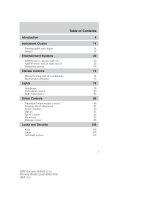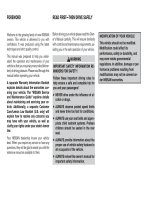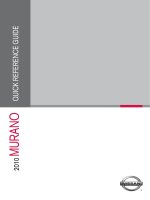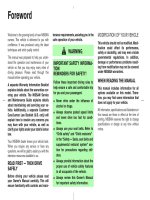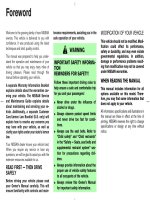OWNER 329
Bạn đang xem bản rút gọn của tài liệu. Xem và tải ngay bản đầy đủ của tài liệu tại đây (106.05 KB, 10 trang )
SƠ GD&ĐT VINH PHUC
TRƯƠNG THPT LIÊN SƠN
(Đề thi gồm: 05 trang)
ĐỀ KTCL ƠN THI THPT QUỐC GIA NĂM 20172018
Mơn: TIẾNG ANH – ĐÊ SỐ 329
Thời gian làm bài: 60 phút, không kể thời gian phát
đề
Ho va tên thi sinh:……………………………………………………………………. SBD:…………………………
Mark the letter A, B, C or D on your answer sheet to indicate the word whose underline part
differs from the other three in pronunciation in each of the following questions.
Question 01:
A. looked
B. laughed
C. decided
D. experienced
Question 02:
A. break
B. increase
C. speak
D. cheat
Mark the letter A, B, C or D on your answer sheet to indicate the correct answer to each of the
following question.
Question 03: There were some rainy days, but it was a nice holiday_________.
A. in general
B. by all means
C. by no means
D. in particular
Question 04: Some people say that in the future the whole world will experience a period of_________
depression.
A. economics
B. economic
C. economical
D. economy
Question 05: If Mary had been invited, she_________ to the party.
A. would come
B. came
C. will come
D. would have come
Question 06: There are few employment prospects for_________ young people.
A. qualify
B. qualification
C. qualified
D. unqualified
Question 07: Using the new software, _________ parents will be able to monitor their children’s use of
_________ Internet.
A. the/the
B. Ø/the
C. Ø/Ø
D. the/Ø
Question 08: I recommended that she_________ reduce her expenditure.
A. should
B. must
C. need
D. would
Question 09: It was_________ that I saw it several times.
A. so an interesting film
B. such an interesting film
C. such film an interesting
D. so interested a film
Question 10: _________ hard I have ever worked, I do not get good salary.
A. If
B. Provided that
C. Nevertheless
D. However
Question 11: A species that faces_________ may become severely endangered or even extinct.
A. overpopulation B. overgrowth
C. overbalance
D. overexploitation
Question 12: It is important to have a close friend to_________ in.
A. confide
B. contact
C. confirm
D. consult
Question 13: A skilled_________ will help candidates feel relaxed.
A. interviewee
B. interviewing
C. interviewerD. interview
Question 14: What she said made me aware of my own_________ .
A. shortcomings
B. shortages
C. shortnesses
D. shortenings
Mark the letter A, B, C or D on your answer sheet to indicate the most suitable response to
complete each of the following exchanges.
Question 15: ~ Barne: “____________” ~ Andy: “What about perfume? There's a department store
across the road.”
A. What can I buy my sister for her birthday?
B. Are you wearing perfume today, Ann?
C. Do you think perfume is a good birthday present?
D. My girl friend adores French perfume.
Question 16: ~ Andy: "What shall we do today?" ~ Jack: “____________”
A. We’re having a maths test at 10 a.m.
B. I got a new computer game for my birthday. We could play that.
C. I’m too tired to do anything.
D. Let’s give him a big hand.
Mark the letter A, B, C or D on your answer sheet to indicate the word(s) CLOSEST in meaning to
the underlined word(s) in each of the following questions.
Question 17: During the recession, many small companies were eradicated.
A. taken over
B. wiped out
C. run on
D. set up
Question 18: It is really incredible that he is unaware of such basic facts.
A. difficult
B. unbelievable
C. imaginable
D. disappointed
Mark the letter A, B, C, or D on your answer sheet to indicate the sentence that best combines
each pair of sentences in the following questions.
Question 19: The agreement ended six-month negotiation. It was signed yesterday.
A. The negotiation which lasted six months was signed yesterday.
B. The agreement which was signed yesterday lasted six months.
C. The agreement which was signed yesterday ended six-month negotiation.
D. The agreement which ends six-month negotiation was signed yesterday.
Question 20: I did not arrive in time. I was not able to see her off.
A. She had left because I was not on time.
B. I was not early enough to see her off.
C. I arrived very late to say goodbye to her.
D. I did not go there, so I could not see her off.
Mark the letter A, B, C or D on your answer sheet to indicate the word(s) OPPOSITE in meaning
to the underlined word(s) in each of the following questions.
Question 21: I don’t like the way he refers to his problems obliquely.
A. directly
B. politely
C. impolitely
D. indirectly
Question 22: They have not made any efforts to integrate with the local community.
A. separate
B. put together
C. cooperate
D. connect
Read the following passage and mark the letter A, B, C, or D on your answer sheet to indicate
the correct answer to each of the questions.
Of all modern instruments, the violin is apparently one of the simplest. It consist in essence of
a hollow, varnished wooden sound box, or resonator, and a long neck covered with a fingerboard,
along which four strings are stretched at high tension. The beauty of design, shape, and decoration
is no accident, the proportions of the instrument are determined entirely by acoustical
considerations. Its simplicity of appearance is deceptive. About 70 parts are involved in the
construction of a violin. Its tone and its outstanding range of expressiveness make it an ideal solo
instrument. No less important, however, is its role as an orchestral and chamber instrument In I
combination with the larger and deeper-sounding members of the same family, the violins form the
nucleusof the modem symphony orchestra.
The violin has been in existence since about 1550. Its importance as an instrument in its own
right dates from the early 1600’s, when it first became standard in Italian opera orchestras. Its
stature as an orchestral instrument was raised further when in 1626 Louis XIII of France
established at his court the orchestra known as Les vinq-quatre violons du Roy (The King's 24
Violins), which was to become widely famous later in the century.
In its early history, the violin had a dull and rather quiet tone resulting from the fact that the
strings were thick and were attached to the body of the instrument very loosely. During the
eighteenth and nineteenth century exciting technical changes were inspired by such composerviolinists as Vivaldi and Tartini. Their instrumental compositions demanded a fuller, clearer, and
more brilliant tone that was produced by using thinner strings and a far higher string tension. Small
changes had to be made to the violin's internal structure and to the fingerboard so that they could
withstand the extra strain. Accordingly, a higher standard of performance was achieved, in terms of
both facility and interpretation. Left-hand technique was considerably elaborated, and new
fingering patterns on the fingerboard were developed for very high notes.
Question 23: The word “they” in the passage refers to___________.
A. internal structure and fingerboard
C. small changes
B. thinner strings and a higher string tension
D. Civaldi and Tartini
Question 24: The author mentions Vivaldi and Tartini in passage as examples of composers whose
music___________.
A. had to be adapted to the violin
B. demanded more sophisticated violins
C. inspired more people to play the violin
D. could be played by only their students
Question 25: According to the passage, which of the following contributes to a dull sound being
produced by a violin?
A. thick strings
B. high string tension
C. A long fingerboard D. a small body
Question 26: According to the passage, early violins were different from modern violins in that early
violins____________.
A. broke down more easily
B. were heavier
C. were easier to play
D. produced softer tones
Question 27: What is the main idea presented in paragraph 3?
A. The violin had reached the height of its popularity by the middle of the eighteenth century.
B. The violin has been modified to fit its evolving musical functions.
C. The technique of playing the violin has remained essentially the same since the 1600's.
D. The violin is probably the best known and most widely distributed musical instrument in
the world.
Question 28: The word “strain” is closest meaning to___________.
A. struggle
B. strength
C. stress
D. strategy
Question 29: All of the following are mentioned in the passage as contributing to the ability to play
modern violin music EXCEPT___________.
A. different ways to use the fingers to play very high notes
B. use of rare wood for the fingerboard and neck
C. more complicated techniques for the left hand
D. minor alterations to the structure of the instrument
Question 30: The word "standard" is closest in meaning to___________.
A. practical
B. unusual
C. possible
D. customary
Read the following passage and mark the letter A, B, C, or D on your answer sheet to indicate
the correct word or phrase that best fits each of the numbered blanks from 31 to 35.
Private school is not controlled by the government and is not supported by taxes or other
public funds. A private school differs (31)__________ a public school, which operates with major
support from government funds. Private schools are operated by religion groups or by independent
organizations. Most private schools operate on a non-profit basis, although a few are run as
businesses to make money for their owners. Private schools are (32)__________ chiefly by tuition,
grants from their sponsors or contributions. Some private schools also have an invested money
whose income is used to fund the school. In most countries, almost all schools were private until the
early 1800’s. At that time, many government leaders began to encourage development of public
schools to promote national progress by making education widely available to citizens. Today, the
(33)__________ of public and private schools differs greatly from one country to another. In many
developed countries, private schools offer a general focus on (34)__________ for college, a special
focus on science, music or other subject areas; and religious instruction. The Roman Catholic Church
is one of the largest sponsors of private schools (35)__________ the world.
Question 31:
A. than
B. that
C. from
D. more
Question 32:
A. funded
B. given
C. raised
D. fed
Question 33:
A. amount
B. digit
C. number
D. figure
Question 34:
A. coming
B. participation
C. enter
D. preparation
Question 35:
A. out
B. on
C. all
D. throughout
Mark the letter A, B, C or D on your answer sheet to indicate the sentence that is closest in
meaning to each of the following questions.
Question 36: As long as you stay calm, you have nothing to fear from the interview.
A. Provided you do not get nervous, the interview won‘t go badly for you.
B. Even if you are afraid of the interview, it is important not to let it show.
C. Interviews are only intimidating for people who are not extremely calm.
D. You have remained calm for a long time in spite of your fear of the interview.
Question 37: It's more than a couple of years since I last went there.
A. It was only after two years that I went there again.
B. I have never stayed there for longer than two years.
C. I had never been there until the year before last.
D. I haven‘t been there since my visit over two years ago.
Question 38: At last, an agreement has been reached by the committee members on the proposal to
build a new dam.
A. The members of the committee for the new dam proposal have been selected at last.
B. The members of the committee have finally agreed about the new dam proposal.
C. Having reached an agreement about the dam at the last meeting, the committee members
now have a new proposal.
D. In order that an agreement concerning the dam can be reached, it has been proposed that
the committee should come together immediately.
Mark the letter A, B, C or D in your answer sheet to indicate the underlined part that needs
correction in each of the following questions.
Question 39: Energy exists in different forms such as light, heat, and chemical, mechanic and
electrical energy. A. in
B. mechanic
C. electrical
D. forms
Question 40: She told me whether she could look after the kids from time to time.
A. could
B. told
C. the
D. to time
Question 41: He threatened his daughter not to speak to her again if she married that man.
A. if
B. not to speak
C. threatened
D. married
Mark the letter A, B, C or D on your answer sheet to indicate the word that differs from the
other three in the position of primary stress in each of the following questions.
Question 42:
A. environment B. optimistic
C. electricity
D. unexpected
Question 43:
A. stable
B. country
C. border
D. campaign
Read the following passage and mark the letter A, B, C, or D on your answer sheet to indicate
the correct answer to each of the questions.
As our meeting places fall silent, save for tapping on screens, it seems we have mistaken connection for
the real thing. Simon Jenkins
I first noticed it in a restaurant. The place was oddly quiet, and at one table a group sat with
their heads bowed, their eyes hooded and their hands in their laps. I then realised that every one,
whatever their age group, was gazing at a handheld phone or tablet. People strolled in the street
outside likewise, with arms at right angles, necks bent and heads in awkward postures. Mothers
with babies were doing it. Students in groups were doing it. The scene resembled something from
an old science fiction film. There was no conversation.
Every visit to California convinces me that the digital revolution is over, by which I mean it is
won. Everyone is connected. The New York Times last week declared the death of conversation.
While mobile phones may at last be falling victim to considerate behaviour, this is largely because
even talk is considered too intimate a contact. No such bar applies to emailing, texting, messaging,
posting and tweeting. It is ubiquitous, the ultimate connectivity, the brain wired full-time to infinity.
The MIT professor and psychologist Sherry Turkle claims that her students are close to
mastering the art of maintaining eye contact with a person while texting someone else. It is like an
organist playing different tunes with hands and feet. To Turkle, these people are ‘alone together … a
tribe of one’. Anyone with 3,000 Facebook friends has none.
The audience in many theatres now sit, row on row, with lit machines in their laps, looking to
the stage occasionally but mostly scrolling and tapping away. The same happens at meetings and
lectures, in coffee bars and on jogging tracks. Psychologists have identified this as ‘fear of
conversation’, and have come up with the term ‘conversational avoidance devices’ for headphones.
In consequence, there is now a booming demand for online ‘conversation’ with robots and
artificial voices. Mobiles come loaded with customised ‘boyfriends’ or ‘girlfriends’. People sign up
with computerised dating advisors, even claim to fall in love with their on-board GPS guides. A robot
seal can be picked up in online stores to sit and listen to elderly individuals talk, tilting its head and
blinking in sympathy.
In his Conversation: A History of a Declining Art, Stephen Miller notes that public discourse is
now dominated by ill-tempered disagreement, by ‘intersecting monologues’. Anger and lack of
restraint are treated as assets in public debate, in place of a willingness to listen and adjust one’s
point of view. Politics thus becomes a platform of rival angers. American politicians are ever more
polarised, reduced to conveying a genuine hatred for each other.
All that said, the death of conversation has been announced as often as that of the book. As
far back as the 18th century, the literary figure Samuel Johnson worried that the decline of political
conversation would lead to violent civil disorder. Writing 70 years ago, George Orwell concluded
that ‘the trend of the age was away from creative communal amusements and towards solitary
mechanical ones’. Somehow we have muddled through.
The ‘post-digital’ phenomenon, the craving for live experience, is showing a remarkable
vigour. The US is a place of ever greater congregation and migration, to parks, beaches and
restaurants, to concerts, rock festivals, ball games. Common interest groups, springing up across the
country, desperately seek escape from the digital dictatorship, using Facebook and Twitter not as
destinations but as route maps to meet up with real people.
Somewhere in this cultural mix I am convinced the desire for friendship will preserve the
qualities essential for a civilised life, qualities of politeness, listening and courtesy. Those obsessed
with fashionable connectivity and personal avoidance are not escaping reality. They may be
unaware of it but deep down they, too, still want someone to talk to.
Question 44: The writer believes the main reason for the decreasing use of mobile phones is________
A. an overall reduction in the use of electronic devices for communication.
B. the realisation that it is bad manners to use them in public places.
C. a general feeling that they are rapidly becoming obsolete technology.
D. the fact that people are increasingly reluctant to speak to one another.
Question 45: According to Sherry Turkle, certain people nowadays are________
A. electronically connected but isolated from genuine human interaction.
B. more skillful at communicating with others via music than in words.
C. incapable of forming true friendships except through social media.
D. determined to return to a more traditional form of social structure.
Question 46: The word ‘ubiquitous’ in paragraph 2 is closest in meaning to________
A. overwhelming
B. unique
C. found everywhere
D. encroaching
Question 47: The writer mentions ‘the book’ in paragraph 7 as________
A. an example of something else that people wrongly predicted would disappear.
B. a way of introducing the works of famous writers from earlier centuries.
C. the basis of the theory that people would soon stop talking to each other.
D. the source of information about the current state of political debate in the USA.
Question 48: The writer uses the example of the ‘seal‘ in paragraph 5 to show________
A. how robots can help those unable to find a romantic partner.
B. the negative impact of internet search engines on conversation.
C. how far the technology of artificial intelligence has progressed.
D. that electronic companions are regarded as non-threatening.
Question 49: What point does the writer make in the final paragraph?
A. Only those who remain polite and courteous will have friends.
B. Nobody can escape the negative effects of the digital revolution.
C. Some traditional human values are eventually bound to disappear.
D. Everybody needs human contact whether they realise it or not.
Question 50: What point is made in the sixth paragraph about the current nature of public discussion?
A. Speakers are expected to behave aggressively towards each other.
B. Political parties are becoming increasingly extreme in their views.
C. Fewer people dare to contradict the opinions of other speakers.
D. The behaviour of public figures reflects lower standards in society.
_________THE END_________
SƠ GD&ĐT VINH PHUC
ĐỀ KTCL ÔN THI THPT QUỐC GIA NĂM 2017TRƯƠNG THPT LIÊN SƠN
2018
(Đề thi gồm: 05 trang)
Môn: TIẾNG ANH – ĐÊ SỐ 329
Thời gian làm bài: 60 phút, không kể thời gian phát
đề
Ho va tên thi sinh:……………………………………………………………………. SBD:…………………………
Mark the letter A, B, C or D on your answer sheet to indicate the word whose underline part
differs from the other three in pronunciation in each of the following questions.
Question 01:
A. looked
B. laughed
C. decided
D. experienced
Question 02:
A. break
B. increase
C. speak
D. cheat
Mark the letter A, B, C or D on your answer sheet to indicate the correct answer to each of the
following question.
Question 03: There were some rainy days, but it was a nice holiday_________.
A. in general
B. by all means
C. by no means
D. in particular
Question 04: Some people say that in the future the whole world will experience a period of_________
depression.
A. economics
B. economic
C. economical
D. economy
Question 05: If Mary had been invited, she_________ to the party.
A. would come
B. came
C. will come
D. would have come
Question 06: There are few employment prospects for_________ young people.
A. qualify
B. qualification
C. qualified
D. unqualified
Question 07: Using the new software, _________ parents will be able to monitor their children’s use of
_________ Internet.
A. the/the
B. Ø/the
C. Ø/Ø
D. the/Ø
Question 08: I recommended that she_________ reduce her expenditure.
A. should
B. must
C. need
D. would
Question 09: It was_________ that I saw it several times.
A. so an interesting film
B. such an interesting film
C. such film an interesting
D. so interested a film
Question 10: _________ hard I have ever worked, I do not get good salary.
A. If
B. Provided that
C. Nevertheless
D. However
Question 11: A species that faces_________ may become severely endangered or even extinct.
A. overpopulation B. overgrowth
C. overbalance
D. overexploitation
Question 12: It is important to have a close friend to_________ in.
A. confide
B. contact
C. confirm
D. consult
Question 13: A skilled_________ will help candidates feel relaxed.
A. interviewee
B. interviewing
C. interviewerD. interview
Question 14: What she said made me aware of my own_________ .
A. shortcomings
B. shortages
C. shortnesses
D. shortenings
Mark the letter A, B, C or D on your answer sheet to indicate the most suitable response to
complete each of the following exchanges.
Question 15: ~ Barne: “____________” ~ Andy: “What about perfume? There's a department store
across the road.”
A. What can I buy my sister for her birthday?
B. Are you wearing perfume today, Ann?
C. Do you think perfume is a good birthday present?
D. My girl friend adores French perfume.
Question 16: ~ Andy: "What shall we do today?" ~ Jack: “____________”
A. We’re having a maths test at 10 a.m.
B. I got a new computer game for my birthday. We could play that.
C. I’m too tired to do anything.
D. Let’s give him a big hand.
Mark the letter A, B, C or D on your answer sheet to indicate the word(s) CLOSEST in meaning to
the underlined word(s) in each of the following questions.
Question 17: During the recession, many small companies were eradicated.
A. taken over
B. wiped out
C. run on
Question 18: It is really incredible that he is unaware of such basic facts.
A. difficult
B. unbelievable
C. imaginable
D. set up
D. disappointed
Mark the letter A, B, C, or D on your answer sheet to indicate the sentence that best combines
each pair of sentences in the following questions.
Question 19: The agreement ended six-month negotiation. It was signed yesterday.
A. The negotiation which lasted six months was signed yesterday.
B. The agreement which was signed yesterday lasted six months.
C. The agreement which was signed yesterday ended six-month negotiation.
D. The agreement which ends six-month negotiation was signed yesterday.
Question 20: I did not arrive in time. I was not able to see her off.
A. She had left because I was not on time.
B. I was not early enough to see her off.
C. I arrived very late to say goodbye to her.
D. I did not go there, so I could not see her off.
Mark the letter A, B, C or D on your answer sheet to indicate the word(s) OPPOSITE in meaning
to the underlined word(s) in each of the following questions.
Question 21: I don’t like the way he refers to his problems obliquely.
A. directly
B. politely
C. impolitely
D. indirectly
Question 22: They have not made any efforts to integrate with the local community.
A. separate
B. put together
C. cooperate
D. connect
Read the following passage and mark the letter A, B, C, or D on your answer sheet to indicate
the correct answer to each of the questions.
Of all modern instruments, the violin is apparently one of the simplest. It consist in essence of
a hollow, varnished wooden sound box, or resonator, and a long neck covered with a fingerboard,
along which four strings are stretched at high tension. The beauty of design, shape, and decoration
is no accident, the proportions of the instrument are determined entirely by acoustical
considerations. Its simplicity of appearance is deceptive. About 70 parts are involved in the
construction of a violin. Its tone and its outstanding range of expressiveness make it an ideal solo
instrument. No less important, however, is its role as an orchestral and chamber instrument In I
combination with the larger and deeper-sounding members of the same family, the violins form the
nucleusof the modem symphony orchestra.
The violin has been in existence since about 1550. Its importance as an instrument in its own
right dates from the early 1600’s, when it first became standard in Italian opera orchestras. Its
stature as an orchestral instrument was raised further when in 1626 Louis XIII of France
established at his court the orchestra known as Les vinq-quatre violons du Roy (The King's 24
Violins), which was to become widely famous later in the century.
In its early history, the violin had a dull and rather quiet tone resulting from the fact that the
strings were thick and were attached to the body of the instrument very loosely. During the
eighteenth and nineteenth century exciting technical changes were inspired by such composerviolinists as Vivaldi and Tartini. Their instrumental compositions demanded a fuller, clearer, and
more brilliant tone that was produced by using thinner strings and a far higher string tension. Small
changes had to be made to the violin's internal structure and to the fingerboard so that they could
withstand the extra strain. Accordingly, a higher standard of performance was achieved, in terms of
both facility and interpretation. Left-hand technique was considerably elaborated, and new
fingering patterns on the fingerboard were developed for very high notes.
Question 23: The word “they” in the passage refers to___________.
A. internal structure and fingerboard
C. small changes
B. thinner strings and a higher string tension
D. Civaldi and Tartini
Question 24: The author mentions Vivaldi and Tartini in passage as examples of composers whose
music___________.
A. had to be adapted to the violin
B. demanded more sophisticated violins
C. inspired more people to play the violin
D. could be played by only their students
Question 25: According to the passage, which of the following contributes to a dull sound being
produced by a violin?
A. thick strings
B. high string tension
C. A long fingerboard D. a small body
Question 26: According to the passage, early violins were different from modern violins in that early
violins____________.
A. broke down more easily
B. were heavier
C. were easier to play
D. produced softer tones
Question 27: What is the main idea presented in paragraph 3?
A. The violin had reached the height of its popularity by the middle of the eighteenth century.
B. The violin has been modified to fit its evolving musical functions.
C. The technique of playing the violin has remained essentially the same since the 1600's.
D. The violin is probably the best known and most widely distributed musical instrument in
the world.
Question 28: The word “strain” is closest meaning to___________.
A. struggle
B. strength
C. stress
D. strategy
Question 29: All of the following are mentioned in the passage as contributing to the ability to play
modern violin music EXCEPT___________.
A. different ways to use the fingers to play very high notes
B. use of rare wood for the fingerboard and neck
C. more complicated techniques for the left hand
D. minor alterations to the structure of the instrument
Question 30: The word "standard" is closest in meaning to___________.
A. practical
B. unusual
C. possible
D. customary
Read the following passage and mark the letter A, B, C, or D on your answer sheet to indicate
the correct word or phrase that best fits each of the numbered blanks from 31 to 35.
Private school is not controlled by the government and is not supported by taxes or other
public funds. A private school differs (31)__________ a public school, which operates with major
support from government funds. Private schools are operated by religion groups or by independent
organizations. Most private schools operate on a non-profit basis, although a few are run as
businesses to make money for their owners. Private schools are (32)__________ chiefly by tuition,
grants from their sponsors or contributions. Some private schools also have an invested money
whose income is used to fund the school. In most countries, almost all schools were private until the
early 1800’s. At that time, many government leaders began to encourage development of public
schools to promote national progress by making education widely available to citizens. Today, the
(33)__________ of public and private schools differs greatly from one country to another. In many
developed countries, private schools offer a general focus on (34)__________ for college, a special
focus on science, music or other subject areas; and religious instruction. The Roman Catholic Church
is one of the largest sponsors of private schools (35)__________ the world.
Question 31:
A. than
B. that
C. from
D. more
Question 32:
A. funded
B. given
C. raised
D. fed
Question 33:
A. amount
B. digit
C. number
D. figure
Question 34:
A. coming
B. participation
C. enter
D. preparation
Question 35:
A. out
B. on
C. all
D. throughout
Mark the letter A, B, C or D on your answer sheet to indicate the sentence that is closest in
meaning to each of the following questions.
Question 36: As long as you stay calm, you have nothing to fear from the interview.
A. Provided you do not get nervous, the interview won‘t go badly for you.
B. Even if you are afraid of the interview, it is important not to let it show.
C. Interviews are only intimidating for people who are not extremely calm.
D. You have remained calm for a long time in spite of your fear of the interview.
Question 37: It's more than a couple of years since I last went there.
A. It was only after two years that I went there again.
B. I have never stayed there for longer than two years.
C. I had never been there until the year before last.
D. I haven‘t been there since my visit over two years ago.
Question 38: At last, an agreement has been reached by the committee members on the proposal to
build a new dam.
A. The members of the committee for the new dam proposal have been selected at last.
B. The members of the committee have finally agreed about the new dam proposal.
C. Having reached an agreement about the dam at the last meeting, the committee members
now have a new proposal.
D. In order that an agreement concerning the dam can be reached, it has been proposed that
the committee should come together immediately.
Mark the letter A, B, C or D in your answer sheet to indicate the underlined part that needs
correction in each of the following questions.
Question 39: Energy exists in different forms such as light, heat, and chemical, mechanic and
electrical energy. A. in
B. mechanic
C. electrical
D. forms
Question 40: She told me whether she could look after the kids from time to time.
A. could
B. told
C. the
D. to time
Question 41: He threatened his daughter not to speak to her again if she married that man.
A. if
B. not to speak
C. threatened
D. married
Mark the letter A, B, C or D on your answer sheet to indicate the word that differs from the
other three in the position of primary stress in each of the following questions.
Question 42:
A. environment B. optimistic
C. electricity
D. unexpected
Question 43:
A. stable
B. country
C. border
D. campaign
Read the following passage and mark the letter A, B, C, or D on your answer sheet to indicate
the correct answer to each of the questions.
As our meeting places fall silent, save for tapping on screens, it seems we have mistaken connection for
the real thing. Simon Jenkins
I first noticed it in a restaurant. The place was oddly quiet, and at one table a group sat with
their heads bowed, their eyes hooded and their hands in their laps. I then realised that every one,
whatever their age group, was gazing at a handheld phone or tablet. People strolled in the street
outside likewise, with arms at right angles, necks bent and heads in awkward postures. Mothers
with babies were doing it. Students in groups were doing it. The scene resembled something from
an old science fiction film. There was no conversation.
Every visit to California convinces me that the digital revolution is over, by which I mean it is
won. Everyone is connected. The New York Times last week declared the death of conversation.
While mobile phones may at last be falling victim to considerate behaviour, this is largely because
even talk is considered too intimate a contact. No such bar applies to emailing, texting, messaging,
posting and tweeting. It is ubiquitous, the ultimate connectivity, the brain wired full-time to infinity.
The MIT professor and psychologist Sherry Turkle claims that her students are close to
mastering the art of maintaining eye contact with a person while texting someone else. It is like an
organist playing different tunes with hands and feet. To Turkle, these people are ‘alone together … a
tribe of one’. Anyone with 3,000 Facebook friends has none.
The audience in many theatres now sit, row on row, with lit machines in their laps, looking to
the stage occasionally but mostly scrolling and tapping away. The same happens at meetings and
lectures, in coffee bars and on jogging tracks. Psychologists have identified this as ‘fear of
conversation’, and have come up with the term ‘conversational avoidance devices’ for headphones.
In consequence, there is now a booming demand for online ‘conversation’ with robots and
artificial voices. Mobiles come loaded with customised ‘boyfriends’ or ‘girlfriends’. People sign up
with computerised dating advisors, even claim to fall in love with their on-board GPS guides. A robot
seal can be picked up in online stores to sit and listen to elderly individuals talk, tilting its head and
blinking in sympathy.
In his Conversation: A History of a Declining Art, Stephen Miller notes that public discourse is
now dominated by ill-tempered disagreement, by ‘intersecting monologues’. Anger and lack of
restraint are treated as assets in public debate, in place of a willingness to listen and adjust one’s
point of view. Politics thus becomes a platform of rival angers. American politicians are ever more
polarised, reduced to conveying a genuine hatred for each other.
All that said, the death of conversation has been announced as often as that of the book. As
far back as the 18th century, the literary figure Samuel Johnson worried that the decline of political
conversation would lead to violent civil disorder. Writing 70 years ago, George Orwell concluded
that ‘the trend of the age was away from creative communal amusements and towards solitary
mechanical ones’. Somehow we have muddled through.
The ‘post-digital’ phenomenon, the craving for live experience, is showing a remarkable
vigour. The US is a place of ever greater congregation and migration, to parks, beaches and
restaurants, to concerts, rock festivals, ball games. Common interest groups, springing up across the
country, desperately seek escape from the digital dictatorship, using Facebook and Twitter not as
destinations but as route maps to meet up with real people.
Somewhere in this cultural mix I am convinced the desire for friendship will preserve the
qualities essential for a civilised life, qualities of politeness, listening and courtesy. Those obsessed
with fashionable connectivity and personal avoidance are not escaping reality. They may be
unaware of it but deep down they, too, still want someone to talk to.
Question 44: The writer believes the main reason for the decreasing use of mobile phones is________
A. an overall reduction in the use of electronic devices for communication.
B. the realisation that it is bad manners to use them in public places.
C. a general feeling that they are rapidly becoming obsolete technology.
D. the fact that people are increasingly reluctant to speak to one another.
Question 45: According to Sherry Turkle, certain people nowadays are________
A. electronically connected but isolated from genuine human interaction.
B. more skillful at communicating with others via music than in words.
C. incapable of forming true friendships except through social media.
D. determined to return to a more traditional form of social structure.
Question 46: The word ‘ubiquitous’ in paragraph 2 is closest in meaning to________
A. overwhelming
B. unique
C. found everywhere
D. encroaching
Question 47: The writer mentions ‘the book’ in paragraph 7 as________
A. an example of something else that people wrongly predicted would disappear.
B. a way of introducing the works of famous writers from earlier centuries.
C. the basis of the theory that people would soon stop talking to each other.
D. the source of information about the current state of political debate in the USA.
Question 48: The writer uses the example of the ‘seal‘ in paragraph 5 to show________
A. how robots can help those unable to find a romantic partner.
B. the negative impact of internet search engines on conversation.
C. how far the technology of artificial intelligence has progressed.
D. that electronic companions are regarded as non-threatening.
Question 49: What point does the writer make in the final paragraph?
A. Only those who remain polite and courteous will have friends.
B. Nobody can escape the negative effects of the digital revolution.
C. Some traditional human values are eventually bound to disappear.
D. Everybody needs human contact whether they realise it or not.
Question 50: What point is made in the sixth paragraph about the current nature of public discussion?
A. Speakers are expected to behave aggressively towards each other.
B. Political parties are becoming increasingly extreme in their views.
C. Fewer people dare to contradict the opinions of other speakers.
D. The behaviour of public figures reflects lower standards in society.
_________THE END_________
